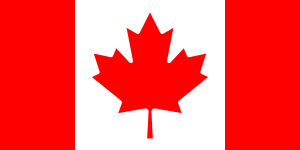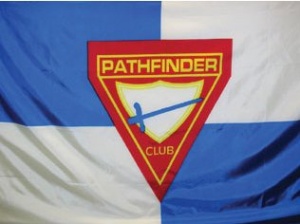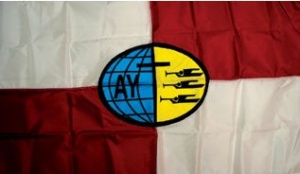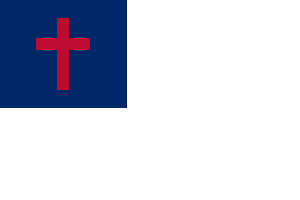AY Honors/Christian Citizenship/Answer Key 4
1. Describe the national, state or provincial, AY, Pathfinder, and Christian flags.
Current provincial flags
Current territorial flags
2. Know how to display the national flag with two other flags under the following situations:
a. Camp out/camporee
b. Fair
c. Pathfinder Day program
d. Parade
a. Camp out/camporee.
If your camp has three flag poles to fly flags from, the National flag should be at the centre. When facing the flags, the second-ranking flag should be on the left, and the third on the right. A common way to fly the flags at camporee is with the Canadian flag in the centre, the Provincial flag to the left, and the Pathfinder flag on the right. (Left and right from the point of view when facing the flag display)
When there are only two flag poles, the position of honour is furthest to the left, and the National flag should be flown there. This also applies if there are four or more flags flown.
The order of precedence for flags is:
1. The National Flag of Canada *
2. The flags of other sovereign nations in alphabetical order
3. The flags of the provinces of Canada
4. The flags of municipalities/cities
5. Banners of organizations (Pathfinder flag etc)
- Her Majesty's Personal Canadian Flag, the standards of members of the Royal Family as well as the standard of the Governor General and the standard of the Lieutenant Governor (in his/her province of jurisdiction and when assuming the duties of the representative of The Queen) take precedence over the National Flag of Canada on the buildings where these dignitaries are in residence or where they are attending a function.
b. c. Fair / Pathfinder day program
When in an auditorium or place of worship, the flag should be placed to the left of the audience (right of the speaker) if placed on the stage or platform. If placed on the floor in front of the platform (called "in the body"), it should be to the right of the audience.
It can also be displayed against the wall behind the speaker. When hanging the flag against a wall, make sure it is right side up (leaf up - stem down). If hanging the flag vertically, the leaf should be to the left, and the stem to the right from the point of view of the audience.
d. When carried in a procession, (On Parade), The following guidelines should be followed.
Single File - the National Flag of Canada should always lead.
In a rank - it is best to have the Canadian flag on each end of the rank. If only one flag is available, it should be placed in the centre of a rank (if the rank has an odd number of people), or on the right hand end (if the rank has an even number of people).
Pole or Pike - the pole used to carry the flags should be 7 or 8 feet in length. (2.1 to 2.4m)
See the following link for more details and illustrations.
Canadian Government rules for flying the flag.
3. Demonstrate how to fold and salute your national flag. Mention when and how it should be displayed.
Folding
There is no official way to fold the Canadian flag, but there are two methods commonly used when the flag is lowered.
1: Prepare the flag for breaking.
Fold the flag two times lengthwise.
Fold it now 3/4 way from end to end. (fly end over hoist end)
Roll from the fold and tie with light cotton string, so the string can be broken to let the flag fly once hoisted.
2: Fold so that a portion of the colours and the maple leaf are visible.
Fold the flag two times lengthwise.
Fold it now from end to end. (fly end over hoist end)
Fold it a second time from end to end. (this time fly end goes under hoist end so part of the leaf remains visible)
The following sites have descriptions and diagrams.
Flag Protocol
There is no law in Canada that tells you about flag etiquette, but there are established traditions. These practices have been in use by the government and citizens of Canada for many years.
The National Flag of Canada should always be treated and displayed with dignity. It should be given precedence over all other national flags when flown in Canada. (Except certain times for Royal Family flags, or the representatives)
The flag should always be flown on its own mast. It is not proper to fly flags below each other on one flag pole. It is allowed to fly the Canadian flag at night, as well as day.
You should never:
- use the flag as a cover for a table or seat. Or for hiding items behind, or as a separating barrier.
- use the flag cover for a statue or plaque unveiling. (while not technically incorrect, this use is discouraged).
- pin or sew something onto the Canadian flag.
- sign or make markings on the flag.
When the flag is tattered and worn, it should be destroyed by burning it privately in a dignified way or by cutting it up so that it is no longer recognizable as a flag. Modern nylon does not burn well.
When the National Flag of Canada is raised or lowered, or when it is carried past in a parade or review, all present should face the flag, men should remove their hats, and all should remain silent. Those in uniform should salute.
4. Explain the meaning of and reason for the National Anthem, and recite the words from memory.
"O Canada" is the national anthem of Canada. The melody was composed by Calixa Lavallée in 1880, who was commissioned by the Lieutenant Governor of Quebec, the Honourable Théodore Robitaille. He was asked to compose a melody to a poem written by Judge Adolphe-Basile Routhier.
The lyric "The True North strong and free" is based on a line from a poem by Alfred Tennyson. He describes Canada as "That True North whereof we lately heard". In his poem, "true" means "loyal" or "faithful".
"O Canada" was not officially proclaimed to be the national anthem of Canada until 1980. On July 1 (Canada Day) 1980 the Governor General, His Excellency the Right Honourable Edward Schreyer, proclaimed the Act respecting the National Anthem of Canada.
Canada has two official languages, English and French. "O Canada" has official lyrics in each language.
- O Canada - English
- O Canada!
- Our home and native land!
- True patriot love in all thy sons command.
- With glowing hearts we see thee rise,
- The True North strong and free!
- From far and wide, O Canada,
- We stand on guard for thee.
- God keep our land glorious and free!
- O Canada, we stand on guard for thee.
- O Canada, we stand on guard for thee.
- O Canada - French
- Ô Canada!
- Terre de nos aïeux,
- Ton front est ceint de fleurons glorieux!
- Car ton bras sait porter l'épée,
- Il sait porter la croix!
- Ton histoire est une épopée
- Des plus brillants exploits.
- Et ta valeur, de foi trempée,
- Protégera nos foyers et nos droits
- Protégera nos foyers et nos droits.
The reason for the National Anthem is to promote patriotism and pride in our country. More info including the rarely used extended lyrcs can be found here.
5. Give the rights and responsibilities of a citizen of your country.
The Canadian Charter of Rights and Freedoms is a bill of rights, and part of the Constitution of Canada. It forms the first part of the Constitution Act, 1982. The Charter guarantees certain political and civil rights of people in Canada.
Canadian Charter of Rights and Freedoms
List of freedoms:
- freedom of conscience
- freedom of religion
- freedom of thought
- freedom of belief
- freedom of expression
- freedom of the press
- freedom of peaceful assembly
- freedom of association.
List of rights:
- Democratic rights: the right to vote and participate in government.
- Mobility rights: the right to come and go from or within Canada, and to live wherever a person chooses.
- Legal rights: rights of people in dealing with the justice system and law enforcement.
- Equality rights: equal treatment before and under the law, and equal protection and benefit of the law without discrimination.
- Language rights: generally, the right to use either the English or French language in communications with Canada's federal government and certain provincial governments.
- Minority language education rights: some rights to be educated in English or French even in minority situations.
Citizens are responsible for:
- Serving on jury when reaching the age of majority, and if selected.
- Obeying Canada's laws.
- Respecting the rights and freedoms of others.
- Helping others in the community.
- Caring for and protecting the Canadian heritage and environment.
- Eliminating discrimination and injustice.
6. Have an interview with a local, regional, or national official of your country, and learn about his duties.
It is generally easier to get a local official to agree to an interview, though it is often more exciting to interview a more prominent person. The interview can be accomplished during a club meeting, and multiple Pathfinders can ask questions. Invite your guest well ahead of time, and make sure everyone in the club is on time. A visit by an official would be a very good reason to have everyone in the club wear their class A uniforms. If desired, you can make up several questions ahead of time, writing them on index cards, and distributing them to the members of your club. But do not be so rigid as to not allow them to ask spontaneous questions. Having questions prepared ahead of time on index cards are a good way to get things rolling. Here are some suggested questions:
- Could you describe a typical day at work?
- What is the most difficult part of your job?
- What is the most satisfying aspect of your job?
- To whom do you report?
- How did you get your position? Were you elected, appointed, or hired?
- How should a young person prepare for a life of public service?
7. Write a one-page essay or give a two-minute oral report about a famous person in your country. Mention what he has done to gain his recognition.
This would be an excellent opportunity to present a worship during the opening exercises of a regular club meeting. Encourage your Pathfinder to choose a person they are personally interested in. If they cannot think of anyone themselves, have a list of suggested persons at hand and encourage them to choose from the list. Famous people might be historical figures, politicians, actors, sports stars, or anyone else. It would be preferable to choose a person who has been a positive influence on the country.
Although the requirement asks that you "mention what he has done to gain his recognition," this should not be interpreted as excluding women. Men are not the only famous people in a country.
Here are some names that may be considered.
- Frederick Banting - Co-discoverer of insulin
- Robert Bateman - Naturalist - Painter
- Alexander Graham Bell - Scientist - Inventor of Telephone
- Roberta Bondar - First Canadian woman astronaut
- Tommy Douglas - Father of Medicare
- Terry Fox - Marathon of Hope
- Rick Hansen - Paraplegic athlete - activist for people with spinal cord injuries
- John A. Macdonald - First Canadian Prime Minister
- John McCrae - Poet - Soldier - In Flanders Fields
- James Naismith - Inventor of Basketball
- David Suzuki - Environmental activist
- Pierre Trudeau - Canadian Prime Minister
- List of famous Canadians
- List of Prime Ministers of Canada
- List of Canadian sports personalities
- List of Canadian musicians
8. Do one of the following:
a. Make a list of ten famous quotations from leaders of your country.
Some Canadian quotes can be found on the WikiQuote article.
These lists of Canadian political leaders will help you find quotes.
- List of Prime Ministers of Canada
- List of Canadian senators
- List of current Canadian first ministers
- List of House members of the 39th Parliament of Canada
b. Make a list of ten famous historic places in your country.
In Canada, the Historic Sites and Monuments Board of Canada, maintains a list of historic sites.
c. Make a list of ten famous historic events in your country.
These events can be political, military, scientific, cultural, or some other type. Here are a few ideas to get you started. Be sure to include the date and a sentence about why the event is famous/important (we are not providing all the answers here).
- Confederation
- Battle of Vimy Ridge (Canadians fought together and it is said the nation was forged on this French battlefield)
- Red River Rebellion
- Formation of the North West Mounted Police todays RCMP)
- Klondike Gold Rush - formation of Yukon
- Terry Fox Marathon of Hope
- Repatriation of the Constitution
- Discovery of Insulin
- War of 1812, American Invasion of Canada, the Burning of Washington, DC
- Formation and Growth of the Hudson's Bay Company
- Establishment of the 49th parallel border in Western Canada
- The Famous Five Case - Are Women Persons
- John Cabot landing in Newfoundland
- Completion of the Canadian Pacific Railway
Check the pages of a recent Canadian passport for more ideas and images of some of these events.
9. Describe what you can do as a citizen to help your church and country.
The best way to help either your church or your country is by getting involved. Edmund Burke, an English philosopher summed this up when he said "The only thing necessary for the triumph of evil is for good men to do nothing."
In your church, this means that you will show up for services on a regular basis. It also means you will support it with your tithes and offering, show up for business meetings, and not wait to be asked before you volunteer your services. If you see something that needs done, do it. If you do not have the skill to do it, or you think that you need permission first, talk to your pastor, an elder, deacon, or deaconess. Find your ministry!
For your country, it is much the same. Show up for public meetings, stay informed about the issues of the day, vote if you are eligible, and pay your taxes fairly and promptly.
10. Go through the steps of an individual acquiring citizenship in the country and learn how this is done.
A person becomes a Citizen of Canada in one of four ways.
1. Is born in Canada.
2. Is born outside Canada, to at least one Canadian parent (who was not also born outside Canada).
3. Applies to become a Citizen of Canada. Applicants must meet a number of requirements.
- must be a permanent resident (a person with permission to live and work in Canada with no end date)
- must be 18 (under 18 must apply with their parents who are applying)
- must have lived in Canada for 3 out of 4 years
- must know about Canada (there is a test)
- must know about the rights and responsibilities of Canadian citizenship
- must be of good character
- must not be a war criminal
- must be able to speak English or French well enough to communicate.
The final step to applying for is to attend a citizenship ceremony to recite and sign The Oath of Citizenship.
English Version: “I swear (or affirm) that I will be faithful and bear true allegiance to Her Majesty Queen Elizabeth II, Queen of Canada, Her Heirs and Successors, and that I will faithfully observe the laws of Canada and fulfil my duties as a Canadian citizen."
4. Be adopted by Canadian parents. Since 2006 children adopted by Canadian citizens can apply for immediate citizenship.
For more details read the following pages.
- Canadian nationality law
- Permanent resident (Canada)
- Oath of citizenship (Canada)
- Immigration to Canada
The Government of Canada maintains a web site called Going to Canada with even more information.
11. Know how to explain the process of government in your country.
In Canada there are three main levels of elected government, plus some appointed positions. Ultimately the Queen of Canada i(shared with the other members of the Commonwealth who recognize her as their queen) is sovereign. She selects a Governor General on the Prime Minister's advice. The Governor General is a largely ceremonial position but there are key decisions required sometimes like agreeing to an election call and selecting a Prime Minister when there may not be a clear choice.
At the national level Canada has a two chamber Westminster style parliament. The most important chamber (but called the lower chamber) is the House of Commons to which MPs are elected by over 300 defined geography Ridings. Each Riding has an associated seat (the MP and his/her party is said to have won the seat/hold the seat. Each seat comes with a literal chair in the House of Commons as well as offices, funding and other trappings of office.
Most but not all elected MPs are members of political party. After an election (or less commonly a vote of no confidence by the house that does not result in an election) the Governor General asked the leader of the party with the most seats to form a government. That leader becomes the Prime Minister, the most powerful political position in Canada. Canadians do not directly vote for the Prime Minister (unlike in the US for example) but rather the Prime Minister is the leader of the governing party and is usually elected as an MP in a single riding. Some Prime Ministers became party leader and Prime Minister without first (or ever in the case of John Turner) holding a seat. A good explanation is given by Rick Mercer.
The Canadian Senate consists of appointed members who are nominated by the Prime Minister. It was designed to reflect regional interests, but is widely criticized for not being elected or effective.
The 10 Canadian Provinces and 3 Territories each have a provincial legislature that consists of elected members (usually called MLAs) from ridings. In Quebec the body is called the National Assembly, but it is still a provincial government. In the provinces the leader of the political party is asked to form a government, just like in the Federal Parliament. In the territories there are usually no political parties and governments are formed by whichever MLA can get enough support from the other MLAs.
While Canada is made up of Provinces that confederated together to create Canada (suggesting the Provinces are somewhat sovereign), local governments for cities, districts, and other local governments are legal creations of the provinces. Generally local politicians are directly elected with the voters selecting a Mayor and Council (or similar titles) for fixed terms.
12. Explain the meaning of this statement Jesus made in Matthew 22:21: "Render therefore unto Caesar the things which are Caesar's, and unto God the things that are God's.
This verse teaches that governmental authority is to be respected, as long as it does not conflict with the moral obligations of being a Christian. Government serves a holy purpose; preserving social order, promoting the well-being of its citizens, and protecting their safety. If you believe that this does not apply today because you see the government as corrupt, you are urged to research the Roman government of the first century A.D. when these words were spoken by Jesus. Was Herod corrupt? Was Pilate just?
13. Explain why laws are established in your country.
Laws are established to provide a framework for a properly functioning society. Laws fall into some broad categories with different purposes, including:
- a) Criminal laws which define illegal acts - for public safety
- b) Tax laws define who must pay taxes and under what circumstances
- c) Administrative laws define how the country is governed
In Canada there is only one set of laws that apply to everyone, including the Prime Minister, Judges, Police, and all individuals.

















